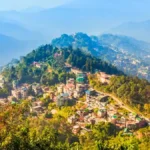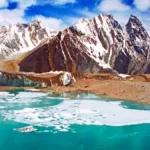Sikkim is a perfect place for spiritual seekers to immerse themselves. The mesmerizing Himalayan scenery, the thunderous Teesta River, and the serenades of the religious groups will all entice you. Sikkim is worth exploring for many reasons beyond its natural beauty as a window into the Himalayas.
Here is some information about The History of Sikkim
The history of Sikkim before the seventeenth century is mostly unknown. The term Su his, which means “new house” in Limbu, is whence the state got its name. In the fifteenth century, the Bhutia began migrating into the region from Tibet. Phuntsog Namgyal, the chief chogyal at the time the kingdom of Sikkim was established in 1642, was descended from the Bhutia ethnic group. Sikkim was controlled by the Namgyal family until 1975.
From the mid-1800s onwards, Sikkim fought a series of regional battles with both Bhutan and Nepal. Around this time, the largest-ever exodus of Nepalese people to Sikkim began. As payment for their assistance during the Anglo-Nepalese War (1814–16), the British returned these areas to Sikkim in 1816; nevertheless, by 1817, Sikkim had become an officially recognized protectorate of Britain.
In 1835, Darjeeling was taken over by the British East India Company from Sikkim. Events between the British and Sikkim led to the expansion of submontane areas in 1849 and the subsequent military destruction of Sikkim.
Sikkim saw the emergence of political meetings after India’s independence in 1947. With the signing of the Indo-Sikkimese Treaty in 1950, Sikkim became a protectorate of India, and India assumed responsibility for Sikkim’s external affairs, security, and important communications. On May 16, 1975, Sikkim was admitted as the 22nd province of India. Sikkim is a landlocked state bounded by sharp mountain ranges on three sides.
Transportation
The main form of transportation in this area is the road. At several locations, ropeways—similar to ski lifts—have also been constructed. Located in West Bengal, the main city of Gangtok is around 70 miles (110 km) from the railhead at Siliguri and over 75 miles (120 km) from the nearest airport at Baghdogra. The state has opened Pakyong, Sikkim, as its first airport.
Assets and power
The state of Sikkim is a mining destination for copper, lead, and zinc. The state also has reserves of many other minerals, including limestone, coal, and graphite. The Teesta River system in Sikkim has considerable hydroelectric potential. Gangtok, Rangpo, Singtam, and Mangan are powered by a few large hydroelectric facilities as well as a large number of smaller ones.
Facts About Sikkim
A state has a variety of historical backgrounds
Sikkim is the only Indian state where a significant fraction of the general populace is of foreign descent, such as Nepal. The Lepcha and Bhutia are two of Sikkim’s other major ethnic groups.
Beautiful and varied flowers may be found there.
The state of Sikkim hosts the International Flower Festival every year in the late spring. Vibrant displays of flowers, orchids, and other plants are on display throughout the festival. It is a small state with around 240 different kinds of trees and greenery, as well as 600 different varieties of orchids. Additionally, there are 46 different varieties of rhododendron and 150 varieties of gladioli. Approximately one-third of all the angiosperms in India are found in Sikkim.
There are many bird species present here.
Sikkim boasts of having over 552 distinct bird species and almost 690 different kinds of butterflies. Amazing! Could we safely conclude that it isn’t? Sikkim is home to the remarkable whiskery vulture, which has ten feet of wings. This lovely state is home to a variety of avian species, including the Himalayan Griffon and the Impeyan Pheasant.
Sikkim predicts its own destiny!
A unique holy water celebration known as Bhum Chu takes place at the Tashiding Monastery, one of Sikkim’s holiest monasteries. This function is said to determine Sikkim’s ultimate destiny.
Did you know that Sikkim has a unique, traditional beverage of its own?
Chaang is a mild, blended beverage made with aged oats. It is the most well-known drink in Sikkim and is enjoyed during parties. The way this drink is delivered is the most interesting aspect of it.
Rich in the natural spa!
The many natural hot springs in Sikkim function similarly to a typical spa. Yumthang Hot Spring, Yume Samdong Hot Spring, Taram Hot Spring, Reshi Hot Spring, Borong Hot Spring, and Ralong Hot Spring are the most well-known regular hot springs. For the greatest benefit, take a lengthy, hot bath in these springs between the months of February and March.
A holy scroll to ward off evil!
Religious scrolls known as thankas are displayed at Sikkim’s monasteries and Buddhist homes. We accept thanks to ward off malevolent spirits. They are seen as holy and auspicious in this sense. Thanka has such exquisite graphics and artwork that it takes many months or maybe longer to complete a single parchment.
A Temple Honoring a Person, not God!
Many temples have been built in honor of various Gods and Goddesses. Nevertheless, how often is a temple constructed in honor of a person? Major “Baba” Harbhajan Singh, an Indian army soldier who is revered as the “Saint of Nathula,” has been accorded this honor.
The third-highest mountain in the world!
Standing at 8,586 meters (28,169 feet) above sea level, Mt. Kanchenjunga in Sikkim is the third-highest peak in the world.
In Sikkim lies the second-highest bridge in Asia!
The Singshore Bridge in Pelling is the second most notable bridge in Asia, measuring 198 meters in length and 220 meters in depth. The view from the scaffold is breathtaking, taking in the pristine valley, towering waterfalls, and lush hillsides.
India’s first organic state!
Sikkim, also known as India’s first Organic State, is the only state in the country to practice natural farming.
What is the brief history of Sikkim?

Sikkim was formerly an independent political territory, but in 1950 it became a protectorate of India, and in 1975 it became a state. Despite its modest size, Sikkim is very important politically and strategically for India because of its placement near multiple international borders. 2,740 square miles, or 7,096 square kilometers.
Who ruled Sikkim before India?

The Namgyal dynasty governed Sikkim from Phuntsog Namgyal, the first chogyal (monarch), until 1975. Darjeeling and the Chumbi Valley, the former of which is now in China, were once a part of the Sikkim monarchy.
Who is the king history of Sikkim?

Phuntsog Namgyal, a prince of the Minyak House who arrived in Sikkim from the Kham district of Tibet and was the fifth-generation descendant of Guru Tashi, established the Namgyal Monarchy (also known as the Chogyal Monarchy), which governed Sikkim from 1642 until 1975.
What is the real name of Sikkim?

A landlocked Indian state tucked away in the Himalayas is called Sikkim (sometimes spelled Sikhim; Devanāgarī: सिक्किम). It is India’s least populated state, with the third-smallest total area, after Delhi and Goa.

